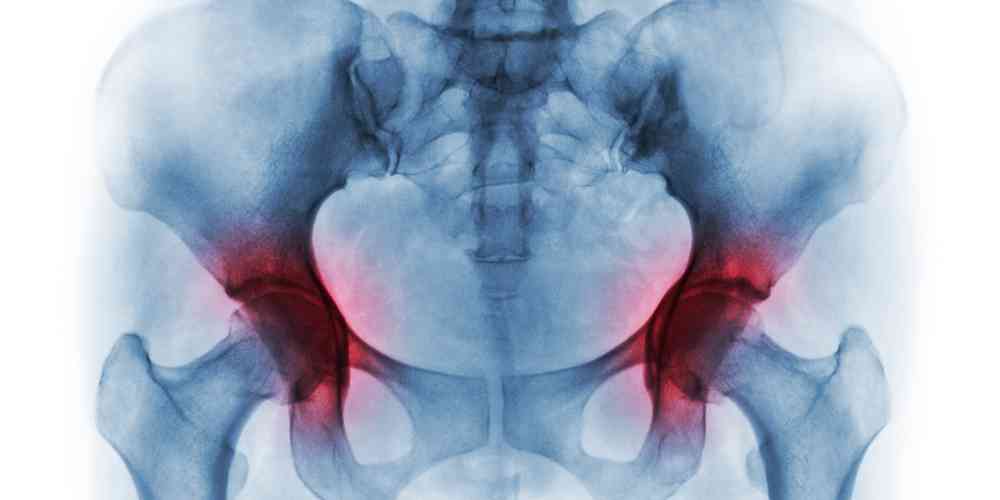What is arthritis of the hip?
The insertion of the head of the femur (thigh bone) into the socket of the acetabulum (pelvis) forms the hip joint. Surrounding the ends of these bones is a layer of slippery white articular cartilage that is responsible for protecting these bones as they glide over one another with joint movement. The socket of the acetabulum is lined with a ring of cartilage that provides strength and stability to the hip joint. Over time, narrowing of the space between the bones occurs from the natural “wear-and-tear” of these cartilaginous tissues. This tissue degeneration is the most common form of arthritis, known as osteoarthritis, and is seen most often in weight-bearing joints such as the hip. If left untreated, the cartilage will continue to erode and result in bone-on-bone movement. Dr. Ronak Mukesh Patel, orthopedic hip specialist serving patients in Sugar Land, Pearland, and the Houston, Texas area, has the knowledge and understanding as well as substantial experience in treating patients who have experienced hip arthritis.

Are there certain risk factors for developing hip arthritis?
Osteoarthritis of the hip is most prevalent among active older adults due to the natural aging process. However, a traumatic hip injury may accelerate cartilage degeneration in younger or non-active individuals. Structural abnormalities that are characteristic of hip dysplasia and femoroacetabular impingement (FAI) can also contribute to the progressive breakdown of cartilage. A misshaped femoral head or extra bone extending beyond the rim of the acetabular socket can interfere with the normal joint mechanics and lead to premature cartilage deterioration.
What are the symptoms of hip arthritis?
Pain in the anterior hip and groin area is the most common complaint in patients with early osteoarthritis of the hip. This pain may progressively worsen over time if left untreated. Patients also frequently report fluctuation of symptom severity with weather changes. Some other common symptoms of hip osteoarthritis can include:
- Hip joint stiffness
- Limited hip range of motion
- Pain is aggravated by increased physical activity
- A “popping” or “crunching” sensation within the affected hip joint
- Abnormal gait or limp
- A “catching” or “grinding” sensation between the bones with joint movement
How is hip arthritis diagnosed?
Osteoarthritis of the hip is diagnosed through a medical history consultation, physical examination, and diagnostic imaging studies. Dr. Patel first obtains a comprehensive medical history with an emphasis on any prior hip injuries or other hip conditions. A thorough physical examination is then performed evaluating the hip for pain, tenderness, and range of motion deficits. X-rays are useful for analyzing the bones of the hip joint for any structural abnormalities and narrowing of the joint space. Magnetic resonance imaging (MRI) allows Dr. Patel to better visualize the soft tissue structures of the hip joint to determine the extent of injury.
What is the treatment for hip arthritis?
Non-surgical treatment:
Non-surgical therapies are often the first line of treatment for patients in the early stages of hip osteoarthritis. Weight loss is highly encouraged to prevent the hip from bearing unnecessary stress. Modifying daily and physical activities can slow the progression of osteoarthritis in the hip joint. A combination of rest, ice, a hip brace, and physical therapy are encouraged to control any symptoms. Oral medications, such as non-steroidal anti-inflammatory medications (NSAIDs), and/or corticosteroid injections are beneficial for managing pain and inflammation. Joint preservation techniques utilizing the patient’s own stem cells or platelet-rich plasma (PRP) can be injected into the injury site to help reduce the pain.
Surgical treatment:
Patients who experience more severe osteoarthritis symptoms may be good candidates for surgical intervention. Dr. Patel can restore the hip joint and alleviate these symptoms by implementing one of two minimally invasive surgical methods. Based on the patient’s specific circumstances, Dr. Patel may combine these surgical techniques to provide the best recovery outcome.
- Hip Arthroscopy: A hip arthroscopy utilizes a small camera (arthroscope) and specialized surgical instruments to remove any damaged tissue fragments and repair the hip labrum. This surgical technique can delay a total hip replacement when performed in the early stages of osteoarthritis.
- Subchondroplasty: A subchondroplasty repairs subchondral lesions of the acetabulum by injecting a bone substitute material. Over time, this material is substituted with healthy bone that provides structural support to the hip joint.
Hip Arthritis Specialist

Osteoarthritis means there is arthritis within the bone, or a bone-on-bone occurrence. Osteoarthritis is most common in weight-bearing joints such as the hip. Patients who are exhibiting early signs of arthritis of the hip, can experience symptoms of pain with increased activity, stiffness in the hip joint, limited range of motion, and popping or crunching sound in the hip. Hip arthritis specialist, Doctor Ronak Mukesh Patel, provides diagnosis as well as surgical and nonsurgical treatment options for patients in Houston, Sugar Land, and Pearland, TX who are experiencing hip arthritis symptoms. Contact Dr. Patel’s team today!








